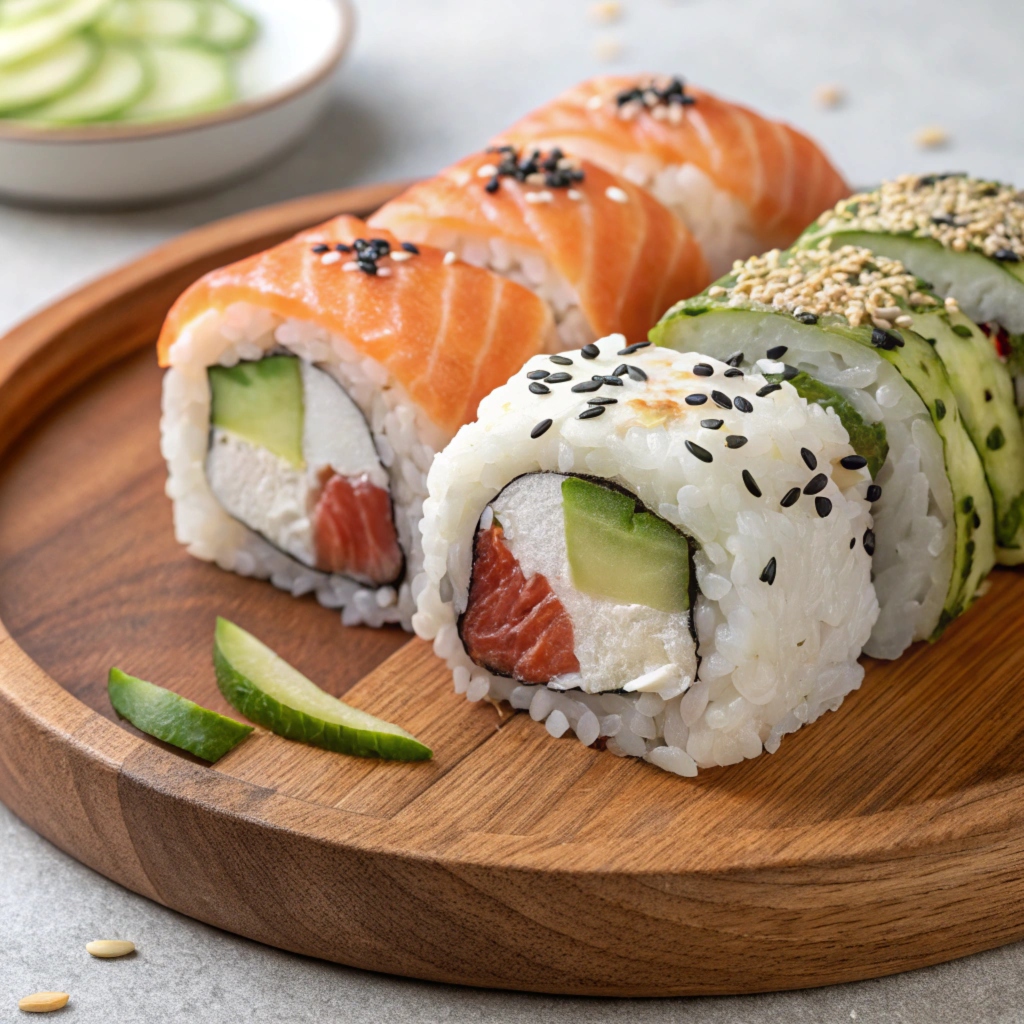When it comes to sushi, the options are endless, and each roll tells its own story. Among the most popular choices in Western sushi restaurants are the Philadelphia roll and the Alaska roll. These two rolls may look similar at first glance, but they have distinct flavors, ingredients, and histories that make each unique. If you’ve ever wondered which one to order, you’re in the right place! Let’s dive into the delicious world of sushi and uncover what makes these rolls so special.
Introduction to Sushi Rolls
Sushi has been a part of Japanese culture for centuries, but the rolls we often enjoy today have been heavily influenced by Western tastes. Traditional Japanese sushi focuses on simplicity, emphasizing the freshness of fish and rice. However, the sushi rolls that became famous in Western countries, like the Philadelphia roll and Alaska roll, introduced bold flavors and ingredients like cream cheese and smoked salmon.
Why do these rolls stand out? It’s all about the perfect balance of textures and flavors, making them crowd favorites. But understanding their differences requires more than a taste test. Let’s break them down!
What Is a Philadelphia Roll?
The Philadelphia roll is a beloved sushi roll known for its creamy and savory flavor. This roll typically includes smoked salmon, cream cheese, and cucumber, all wrapped in seasoned sushi rice and seaweed. It’s a fusion roll that’s become a staple in sushi menus across the globe.
Ingredients Used in a Philadelphia Roll
The key ingredients of a Philadelphia roll are:
- Smoked salmon: Adds a smoky, salty flavor.
- Cream cheese: Gives the roll its signature creaminess.
- Cucumber: Provides a refreshing crunch.
Some variations may include avocado, scallions, or even raw salmon instead of smoked salmon. But cream cheese remains the defining element.
How the Philadelphia Roll Got Its Name
The roll gets its name from Philadelphia cream cheese, a popular brand in the United States. While the roll itself wasn’t created in Philadelphia, the name stuck because of its association with the creamy ingredient.
Popular Variations of the Philadelphia Roll
Many sushi chefs experiment with the Philadelphia roll by adding toppings like spicy mayo, tobiko (fish roe), or sesame seeds. These variations enhance the roll’s flavor profile, making it even more indulgent.
What Is an Alaska Roll?
The Alaska roll, on the other hand, offers a lighter, fresher taste. It’s often made with raw or smoked salmon, cucumber, and avocado. Some variations include a topping of fresh salmon, which gives it a vibrant and elegant appearance.
Ingredients Used in an Alaska Roll
Common ingredients in an Alaska roll include:
- Raw or smoked salmon: A fresh, melt-in-your-mouth flavor.
- Avocado: Adds a creamy texture and a mild, nutty taste.
- Cucumber: Offers a crisp, refreshing bite.
The Origin of the Alaska Roll
Unlike the Philadelphia roll, the Alaska roll doesn’t have a direct connection to its name. It’s believed that the name was inspired by Alaska’s association with fresh, high-quality salmon.
Common Variations of the Alaska Roll
Some chefs top the Alaska roll with thin slices of fresh salmon or even bake the roll with a drizzle of creamy sauce for a richer flavor. This adaptability has made it a favorite for sushi lovers looking to try something new.
Comparing Key Differences Between Philadelphia and Alaska Rolls
Now that we’ve explored what makes each roll unique, let’s dig deeper into their key differences. Whether you’re a sushi enthusiast or a first-time diner, knowing these details can help you decide which roll suits your taste buds better.
Ingredients: Cream Cheese vs. Salmon
The most noticeable difference between the two rolls lies in their main ingredients. The Philadelphia roll prominently features cream cheese, creating a rich and tangy flavor profile. On the other hand, the Alaska roll highlights the natural freshness of salmon, often complemented by avocado and cucumber for a light, balanced taste.
Preparation Techniques
Philadelphia rolls are typically wrapped in seaweed and sushi rice, with smoked salmon or raw salmon as the star ingredient. Alaska rolls, however, are often topped with thin slices of fresh salmon for an elegant presentation. This topping not only enhances the flavor but also gives the roll a striking, vibrant look.
Both rolls share the classic sushi preparation methods of tightly rolling the ingredients with a bamboo mat and slicing them into bite-sized pieces. However, some chefs take creative liberties, like torching the salmon on Alaska rolls or adding spicy sauces to Philadelphia rolls for extra flair.
Taste Profiles
Taste-wise, the Philadelphia roll is creamy and indulgent, with the smoky flavor of the salmon pairing beautifully with the tanginess of the cream cheese. It’s a roll that feels like comfort food for sushi lovers.
In contrast, the Alaska roll offers a fresher, more delicate flavor. The combination of raw salmon, cucumber, and avocado creates a clean, refreshing taste that feels light on the palate.
| Feature | Philadelphia Roll | Alaska Roll |
|---|---|---|
| Main Ingredient | Cream cheese and smoked salmon | Fresh salmon and avocado |
| Flavor | Rich, creamy, smoky | Fresh, light, clean |
| Presentation | Wrapped in rice and seaweed | Topped with fresh salmon slices |
Similarities Between Philadelphia and Alaska Rolls
While their differences are clear, these two rolls share some common traits that make them both beloved by sushi fans.
Core Ingredients
Both rolls use sushi rice and nori (seaweed) as their base, giving them the signature texture and flavor of sushi rolls. Additionally, they often include salmon, whether smoked or raw, as a central ingredient, making them ideal choices for salmon lovers.
Sushi Presentation Style
Presentation is an art in sushi making, and both rolls showcase this beautifully. Whether it’s the clean slices of a Philadelphia roll or the vibrant topping of an Alaska roll, these rolls are designed to look as good as they taste.
Which Roll Is Healthier?
When it comes to nutrition, both rolls have their pros and cons. Let’s break it down to help you make an informed choice.
Nutritional Comparison: Calories, Protein, and Fat
- Philadelphia Roll: The cream cheese in this roll adds a significant amount of calories and fat, making it a more indulgent option. However, the salmon provides healthy omega-3 fatty acids and protein.
- Alaska Roll: With its focus on fresh ingredients like raw salmon, avocado, and cucumber, the Alaska roll is lighter and generally lower in calories. Avocado adds heart-healthy fats, while salmon contributes protein and essential nutrients.
Dietary Preferences and Restrictions
If you’re following a low-fat or low-calorie diet, the Alaska roll may be the better choice. However, if you’re in the mood for a more indulgent treat, the Philadelphia roll delivers with its creamy, savory goodness.
A Quick Tip for Health-Conscious Diners
To keep your sushi experience healthy, pair your rolls with miso soup or a side salad instead of deep-fried appetizers. And remember, moderation is key—sushi is best enjoyed as part of a balanced diet.
The Most Common Problems When Ordering Sushi Rolls
Even though sushi rolls are delicious, dining out or ordering can sometimes lead to a few challenges. Here are the most common problems and how to solve them.
Misidentifying Sushi Rolls
Let’s face it—sushi menus can be overwhelming, especially if you’re not familiar with the names and ingredients. It’s easy to confuse a Philadelphia roll with a similar roll like the salmon avocado roll.
Allergens in Sushi Rolls
Many sushi rolls, including the Philadelphia roll and Alaska roll, contain common allergens like fish, dairy, and sesame. If you have dietary restrictions or allergies, always ask the server for a detailed breakdown of the ingredients.
Pro Tip: When in doubt, request a customized roll. Most sushi chefs are happy to adjust ingredients to suit your needs.
Managing Expectations: Freshness and Authenticity
Not all sushi restaurants are created equal. While high-end sushi bars prioritize freshness and quality, some casual spots might fall short. This can lead to rolls that lack the flavor or texture you’re expecting.
Solutions to Common Sushi Roll Problems
- Ask Questions at the Sushi Bar
Don’t hesitate to ask the chef or server about the ingredients or preparation methods. They’re there to help you have the best experience. - Opt for Customizations
If you want to avoid cream cheese or prefer your roll without avocado, let your server know. Custom orders are a great way to ensure you get exactly what you want.
Tips for Choosing Between Philadelphia and Alaska Rolls
So, now you know the differences, the similarities, and even the nutritional aspects of Philadelphia and Alaska rolls. But how do you choose between the two? Let’s make it simple.
Understanding Your Flavor Preferences
If you love rich and creamy flavors, the Philadelphia roll is your go-to. Its combination of smoked salmon and cream cheese offers a comforting, indulgent experience. Think of it as the sushi equivalent of a decadent dessert—satisfying and full of flavor.
On the other hand, if you prefer something light and fresh, you’ll enjoy the Alaska roll. The raw salmon, avocado, and cucumber create a delicate balance that feels refreshing with every bite. It’s like the sushi version of a crisp salad—clean and invigorating.
Trying Sushi Pairings and Condiments
Both rolls pair beautifully with classic sushi condiments like soy sauce, wasabi, and pickled ginger. However, here are some specific tips to elevate your experience:
- Philadelphia Roll Pairings: A drizzle of eel sauce or a touch of spicy mayo can enhance the creamy texture of the roll.
- Alaska Roll Pairings: Try it with a squeeze of fresh lemon or a sprinkle of sesame seeds for an extra burst of flavor.
Experiment with these combinations to discover what works best for your palate. Sushi is all about creativity, so don’t be afraid to mix and match.
Conclusion: Savoring the World of Sushi Rolls
The Philadelphia roll and Alaska roll are both incredible options, each with its own unique charm. The Philadelphia roll is perfect for those who crave a rich and smoky taste, while the Alaska roll is ideal for those who prefer light, fresh flavors. But why choose one when you can enjoy both?
Exploring different sushi rolls is a journey in itself. Whether you’re dining at a high-end sushi bar or enjoying takeout at home, these rolls offer a delicious introduction to the fusion of traditional Japanese techniques and Western flavors.
Exploring the Best of Both Worlds
Why not try both rolls side by side to see which one you like best? Host a sushi night with friends, order a variety of rolls, and share your favorites. It’s a fun and interactive way to learn more about sushi while satisfying your cravings.
Quote: “Sushi is not just food—it’s an experience, a celebration of flavor, and a journey through culture.”
Experimenting with Your Sushi Experience
Once you’ve mastered the basics, venture into trying other sushi varieties. The world of sushi is vast, with rolls that cater to every preference and dietary need. Who knows—you might even find a new favorite that rivals the Philadelphia or Alaska roll.
A Final Table Recap: Philadelphia Roll vs. Alaska Roll
| Feature | Philadelphia Roll | Alaska Roll |
|---|---|---|
| Main Ingredients | Smoked salmon, cream cheese | Raw salmon, avocado, cucumber |
| Flavor Profile | Rich, creamy, smoky | Light, fresh, clean |
| Presentation | Wrapped in rice and seaweed | Often topped with fresh salmon |
| Calories | Higher due to cream cheese | Lower, depends on ingredients |
| Best For | Indulgent and satisfying sushi | Light and refreshing sushi |
Final Thoughts
Choosing between a Philadelphia roll and an Alaska roll doesn’t have to be a dilemma. Both rolls offer something unique, making them excellent additions to your sushi rotation. The key is to savor the experience, try new things, and enjoy the journey.
Now that you’re armed with all this knowledge, what’s your pick? Let us know, and happy sushi eating!

